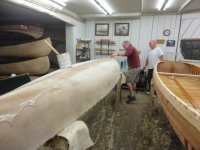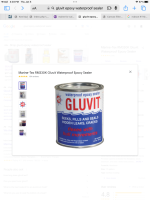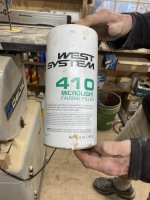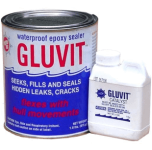He puts on "several" white primer coats, sanding in between them, before putting on several top coats of red paint. Inexperienced me, I didn't realize primer paint was put on over the filler before the outside paint. Is this the standard practice? Since I have some brown paint chipped off the bottom of my Morris, I'm wondering if the white area I see is primer paint or filler. How would I know?
-
Happy Birthday, Noah Webster (1758-1843)! 📘📖🔠
You are using an out of date browser. It may not display this or other websites correctly.
You should upgrade or use an alternative browser.
You should upgrade or use an alternative browser.
Video: Painting a Canvas Canoe, and Some Questions
- Thread starter Glenn MacGrady
- Start date
Is this the standard practice?
The usual joke is 'that's the beauty of standards, there are so many to choose from.' I suspect that each builder has their own 'standard practice' which has probably varied over time. A quick search for "primer" in the WCHA forum at https://www.wcha.org/forums/index.php?search/19822808/&q=primer&o=date will give you an idea of the diversity of opinions on this topic. The white area in the chip you described could be either primer or filler. It is clearly filler if you can see the weave of the canvas. There is a lot of both art and science involved in getting a good finish on a canvas canoe. This problem is further compounded but the constant changes in the paints and other raw materials. These problems are not new. Finish issues were one of the most frequently mentioned problems on the Old Town Canoe Company build records.
Benson
Last edited:
Each person has their own approach, but I like a couple of coats of Interlux high build primer sanded between coats and before paint.
If the last person to paint your canoe was Rollin, I don't think he uses a primer, just multiple coats of paint sanding between coats. It is always possible his technique has changed. Just give him a call to confirm.
If the last person to paint your canoe was Rollin, I don't think he uses a primer, just multiple coats of paint sanding between coats. It is always possible his technique has changed. Just give him a call to confirm.
Last edited:
Just an observation...
The gentleman in the video, Rob Tait of Orca Boats, is using a non-traditional, water-soluble latex filler that is white in color. Then he used a white primer so it would be pretty difficult to spot the difference between the primer and filler layers.
But, traditional oil-based filler is dull grey. R. Thurlow actually makes his own in bulk in a large wash-tub set-up that you can see in the following video:
I'd venture that Rollin is using his own grey filler recipe so there may be some color distinction.
Another thought: Doesn't your Morris replica have a white & dark brown color scheme? I've never painted a two-toned design, but wondering if the whole hull was first painted white and then the bottom section finished in dark brown. If so, perhaps you've chipped the hull down to the white base layer and not all the way to the (assumed) grey filler.
The gentleman in the video, Rob Tait of Orca Boats, is using a non-traditional, water-soluble latex filler that is white in color. Then he used a white primer so it would be pretty difficult to spot the difference between the primer and filler layers.
But, traditional oil-based filler is dull grey. R. Thurlow actually makes his own in bulk in a large wash-tub set-up that you can see in the following video:
I'd venture that Rollin is using his own grey filler recipe so there may be some color distinction.
Another thought: Doesn't your Morris replica have a white & dark brown color scheme? I've never painted a two-toned design, but wondering if the whole hull was first painted white and then the bottom section finished in dark brown. If so, perhaps you've chipped the hull down to the white base layer and not all the way to the (assumed) grey filler.
I use a primer, Pre Kote, and filler color is determined by the color of the paint you use when you mix your own filler. I would just touch it up with a good match.
It sounded like he doesn’t sand between coats of paint till just before the last coat.
Here is filler I mixed with white paint added ( the recipe calls for a quart of oil based paint)
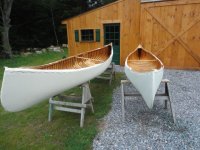
Here’s filler I added gray paint to,
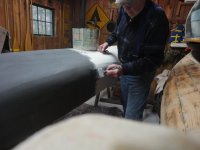
It sounded like he doesn’t sand between coats of paint till just before the last coat.
Here is filler I mixed with white paint added ( the recipe calls for a quart of oil based paint)

Here’s filler I added gray paint to,

Whew! So my question was not as simplistically naive as I was terrified it was. The answer to whether coats of primer paint are used is:
Yes
No
Maybe
The primer paint is mixed in the filler
My guess is that I'll get an equal or greater number of answers if I ask what the ingredients of filler are.
Murat's clever speculation about the white color under my chipped-off brown paint (of which this is the only tiniest example that I have an available picture of) . . .
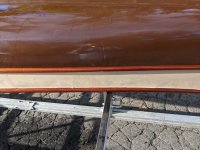
. . . . can only be answered by Rollin Thurlow, likely a busy man.
Meanwhile, I'd like to ask @Robin what the purpose or benefit is of mixing the paint into the filler, an Idea that he perhaps got from MIke Elliott's book, This Old Canoe, or from his mentor Schuyler Thomson.
Yes
No
Maybe
The primer paint is mixed in the filler
My guess is that I'll get an equal or greater number of answers if I ask what the ingredients of filler are.
Murat's clever speculation about the white color under my chipped-off brown paint (of which this is the only tiniest example that I have an available picture of) . . .

. . . . can only be answered by Rollin Thurlow, likely a busy man.
Meanwhile, I'd like to ask @Robin what the purpose or benefit is of mixing the paint into the filler, an Idea that he perhaps got from MIke Elliott's book, This Old Canoe, or from his mentor Schuyler Thomson.
My guess is that I'll get an equal or greater number of answers if I ask what the ingredients of filler are.
Yes, see https://www.wcha.org/forums/index.php?threads/10044/ for more details.
Benson
Meanwhile, I'd like to ask @Robin what the purpose or benefit is of mixing the paint into the filler, an Idea that he perhaps got from MIke Elliott's book, This Old Canoe, or from his mentor Schuyler Thomson.
I don't know why the recipe calls for enamel paint to be added to the ingredients, maybe to help suspend the silica or create a liquid to be able to apply/adhere the filler to the canvas.
I did get the recipe from Mike Elliot's excellent canoe restoration book "This Old Canoe"
I have used Gluvit epoxy over at Schuyler Thomson's shop. He moved so many canoes through there, 3 coats on a canoe are done and dry in 7 days. He couldn't meet the demand if he had to wait 40 days for traditional filler to dry. He has used Gluvit exclusively for as long as I have known him.
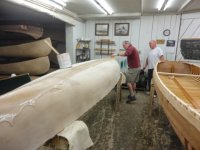
Attachments
Glenn, for what it's worth.... here's what the worst of the abuse on my little Willow canoe looks like after being dragged through an Adirondack bog recently. You may notice that the weave of the canvas is showing through the first coat of repair paint. There are obviously many scrapes and marks which don't penetrate the paint and primer, but there are a couple of spots where filler is showing. I'll apply several layers of paint with sanding between to fill the worst damage, then probably paint the bottom again. My canoes aren't meant to be sawhorse queens, rather, they are used (and a little abused)!
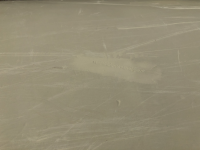

Layers of paint add weight.
My OT Guide came painted white. I just left it that way for 30 years. It is the perfect canvas for drawing. I have no photos of the art work.
My OT Guide came painted white. I just left it that way for 30 years. It is the perfect canvas for drawing. I have no photos of the art work.
Robin…Is this the type Gluvit used? Thanks in advance.I don't know why the recipe calls for enamel paint to be added to the ingredients, maybe to help suspend the silica or create a liquid to be able to apply/adhere the filler to the canvas.
I did get the recipe from Mike Elliot's excellent canoe restoration book "This Old Canoe"
I have used Gluvit epoxy over at Schuyler Thomson's shop. He moved so many canoes through there, 3 coats on a canoe are done and dry in 7 days. He couldn't meet the demand if he had to wait 40 days for traditional filler to dry. He has used Gluvit exclusively for as long as I have known him.
View attachment 133945
Attachments
Just to be clear, since I began talking about paint, that you're talking about mixing West Fairing Filler into the final coat of the voodoo canvas filler recipe, right?
If you mean Gluvit epoxy sealer as the “voodoo recipe” then yes.
I can get specifics from him next time we chat. I believe the first coat of straight Gluvit is just to fill the weave and the next coat has the sandable filler mixed in.
I’m guessing Robin can confirm or correct my memory. I’ve never used it personally, but have seen the quality results.
Bob
I can get specifics from him next time we chat. I believe the first coat of straight Gluvit is just to fill the weave and the next coat has the sandable filler mixed in.
I’m guessing Robin can confirm or correct my memory. I’ve never used it personally, but have seen the quality results.
Bob
Others may be interested in Thomson's filler, since using Gluvit sounds unusual. I was just making sure it wasn't something recommended to go in paint.
So 2 coats of gluvit as per the mix with the catalyst over the bare canvas then a mix with the 410. Any idea what ratio mix?Yes, it's been a while but that is it. Keep in mind, he mixed that West Systems 410 on the final coat to aid in sanding.
View attachment 133954
So 2 coats of gluvit as per the mix with the catalyst over the bare canvas then a mix with the 410. Any idea what ratio mix?
My friend remembers using a half a small coffee can to each of the 3 applications, which makes sense cause they sanded after each coat. Schuyler used a yellow squeegee and made sure not to leave high lines between rows. Hard to sand off.
Iirc, he mixed approx 2/5ths of a gallon for the first coat, less for the second and less for the third. He ended up with some leftover. Sorry, but this was a few years ago and I was just helping my friend so I don’t remember the exact details.
Probably a call to the company’s contact on the can will give better information.
Probably the second coat of gluvit,
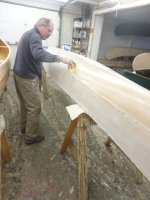
Sanding between coats,
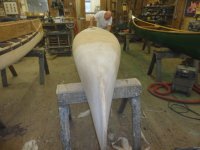
Final coat,
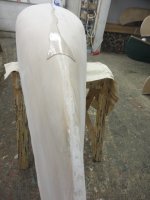
Thanks. Interesting the various types of applications available today. I’m trying sift through them all before deciding which one to do.My friend remembers using a half a small coffee can to each of the 3 applications, which makes sense cause they sanded after each coat. Schuyler used a yellow squeegee and made sure not to leave high lines between rows. Hard to sand off.
Iirc, he mixed approx 2/5ths of a gallon for the first coat, less for the second and less for the third. He ended up with some leftover. Sorry, but this was a few years ago and I was just helping my friend so I don’t remember the exact details.
Probably a call to the company’s contact on the can will give better information.
Probably the second coat of gluvit,
View attachment 133969
Sanding between coats,
View attachment 133972
Final coat,
View attachment 133973
So 2 coats of gluvit as per the mix with the catalyst over the bare canvas then a mix with the 410. Any idea what ratio mix?
I'd like to add in this thread, as I did in Ruttrowe's "Project" thread, another variation of an epoxy-based, fast drying filler, which is discussed in detail and pictured in the three part article linked below. The owner describes a filler developed by Dick Persson of Buckhorn Canoe Company. This process involves coating the planks with three coats of varnish and then spraying on a goodly amount of silicone mold release to prevent the epoxy-based filler from accidentally gluing the canvas to the planks. (He uses the term "mould-release" but I suspect he is misspelling "mold release".)

Re-Canvassing a 1937 Old Town Canoe, Part 1
On January 20th, 1937, my 17′ Old Town HW-model canoe was canvassed at the factory in Old Town, ME. On April 28th, 2013, I decided that at 76 years and 14 weeks I had probably gotten my money…

Re-Canvassing a 1937 Old Town Canoe, Part 2
With three good coats of varnish built up on the outside of the hull, it was time to stretch the canvas. On final precaution against the epoxy filler adhering was to spray the varnished hull exteri…

Re-Canvassing a 1937 Old Town Canoe, Part 3
Once the canvas has been stretched on to the canoe hull, it needs to be filled. This fills the weave and waterproofs the exterior, making a smooth surface for the final coats of paint. To say that …
Similar threads
- Replies
- 8
- Views
- 698
- Replies
- 17
- Views
- 3K
- Replies
- 78
- Views
- 9K

